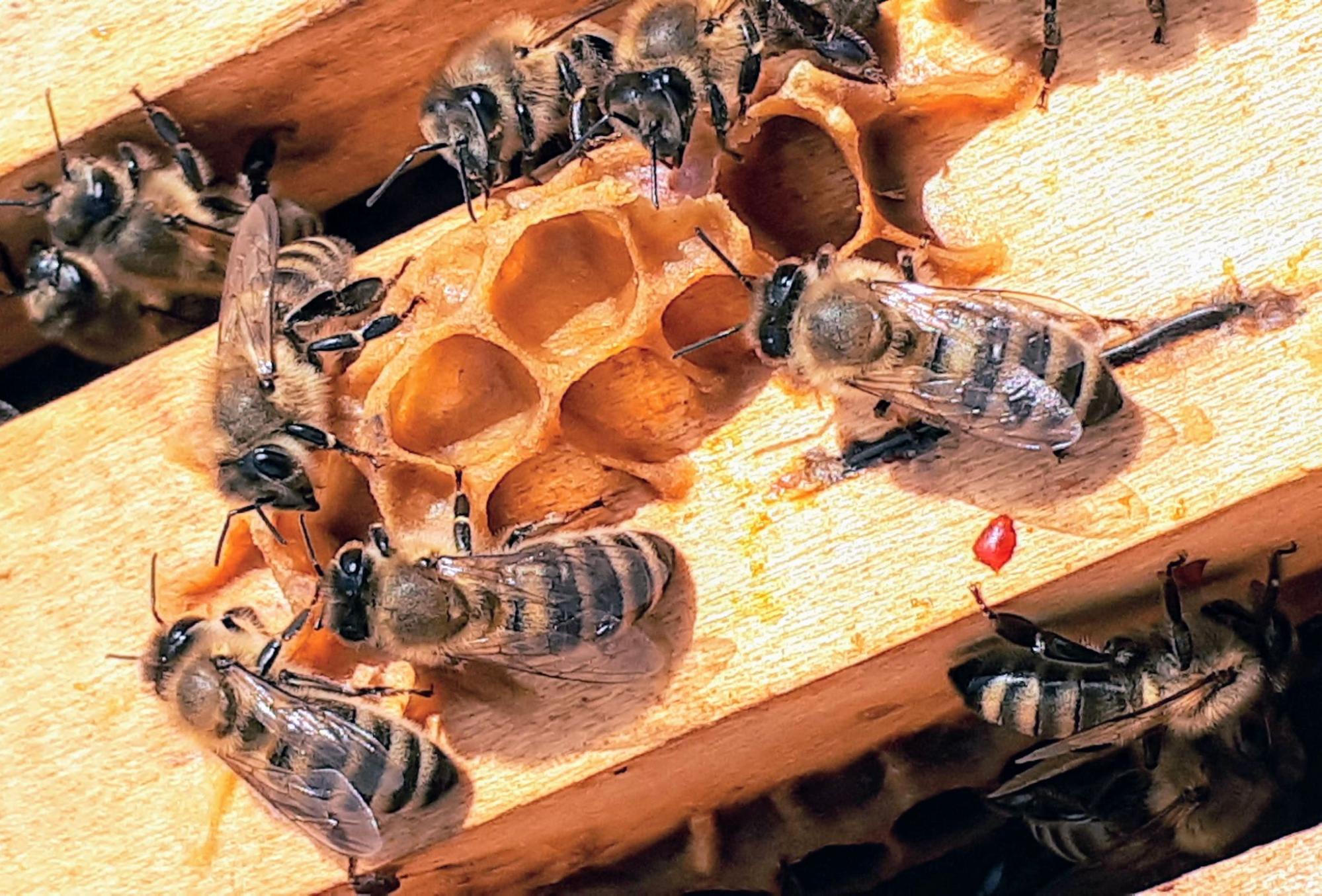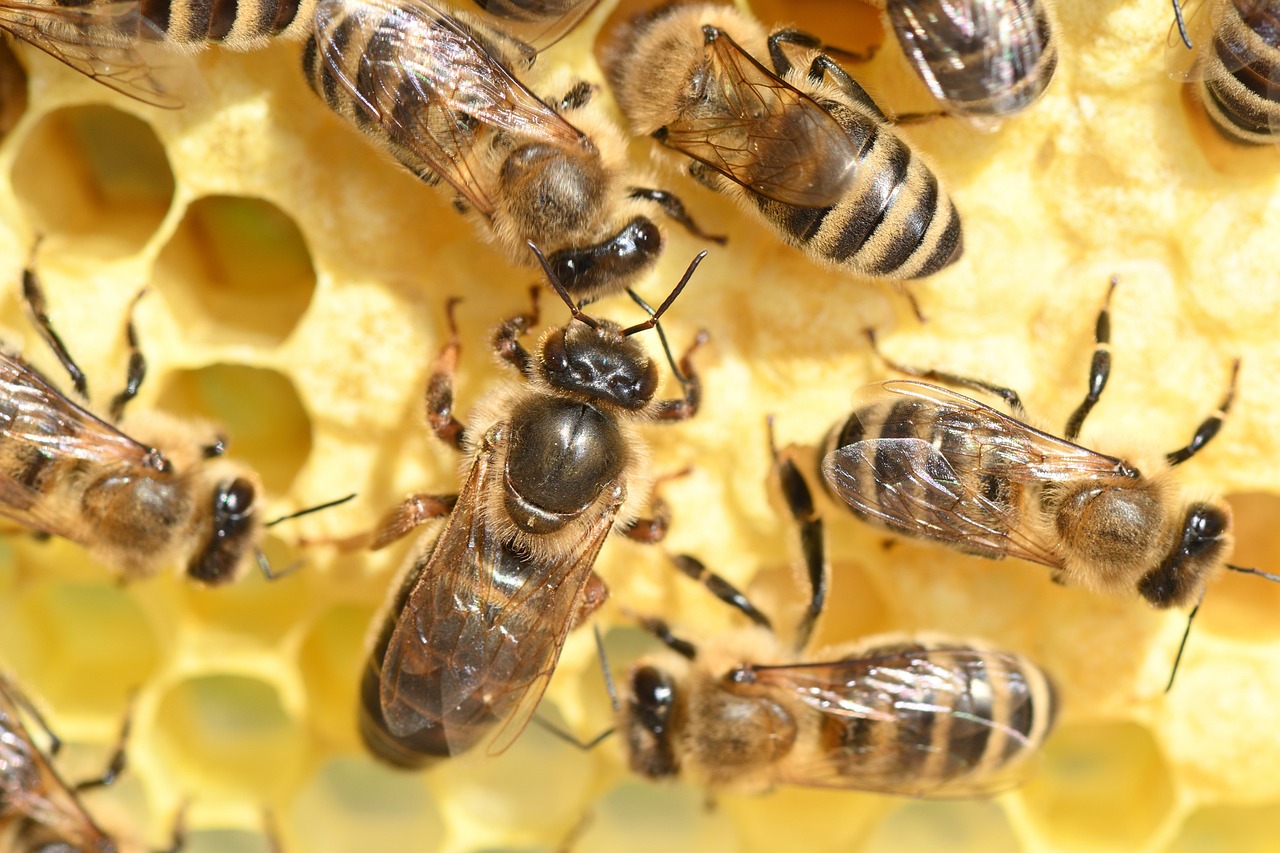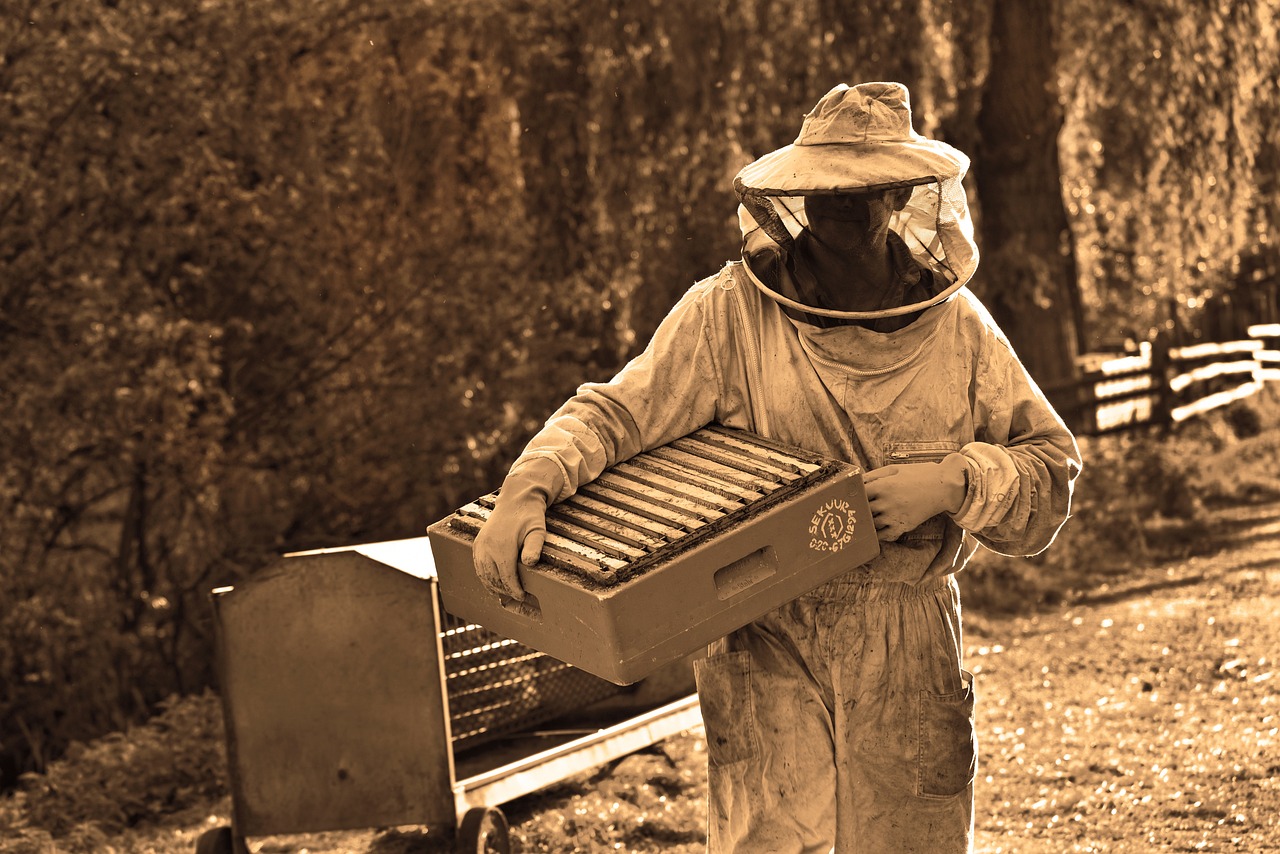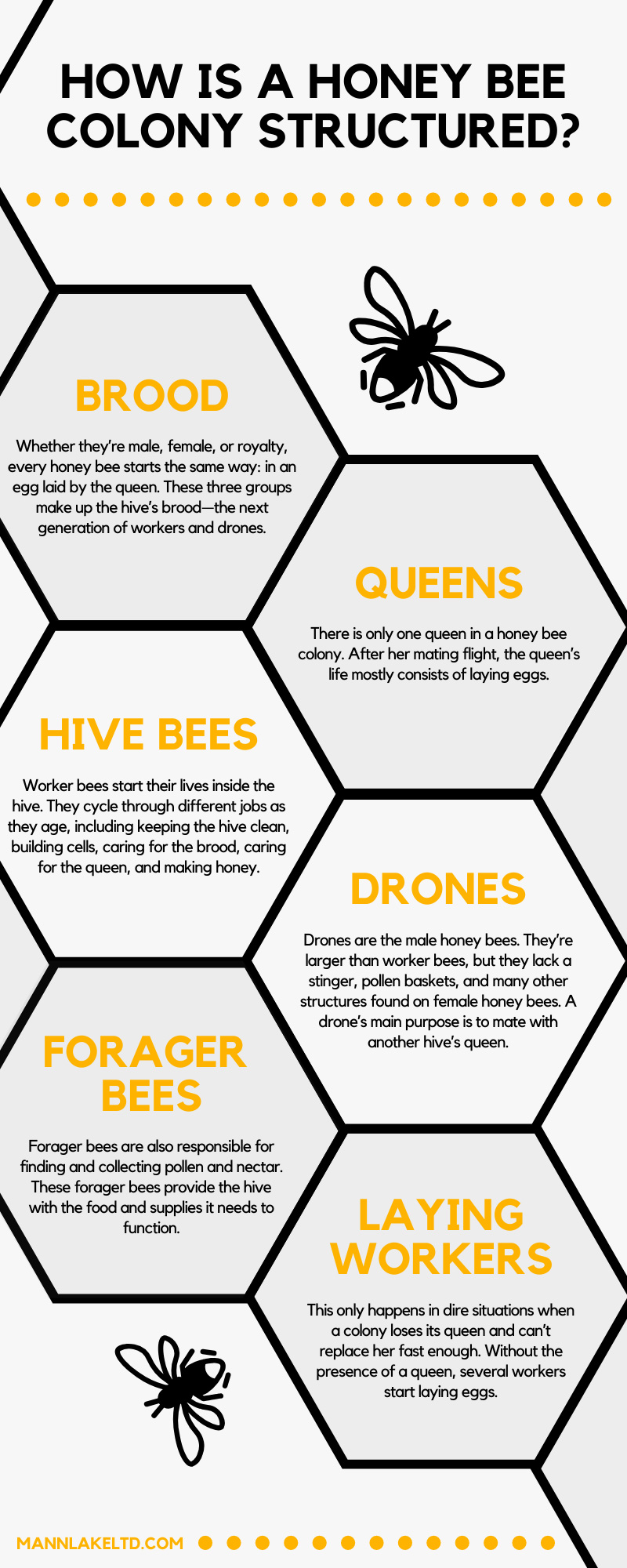How Is A Honey Bee Colony Structured?
Honey bees must be extremely efficient and hard-working to survive. For this reason, a honey bee colony is meticulously organized. Every single member has a role to play in order to feed, raise, and protect the rest of the colony. Honey bees rely on teamwork and communication to grow and sustain a successful colony.
This well-orchestrated activity among the bees showcases not only their hard work but also a deep sense of commitment to the hive.Let’s delve further into understanding how the meticulous organization and interplay of roles define the structure of a honey bee colony.
Brood
Whether they’re male, female, or royalty, every honey bee starts the same way—in an egg laid by the queen. The eggs eventually grow into larvae and then into pupae. These three groups make up the hive’s brood, which are the next generation of workers and drones. There are two types of eggs: fertilized and unfertilized. The fertilized eggs are female bees and develop into worker bees or, on rare occasions, the next queen bee. Unfertilized eggs are male bees, which means they develop into drone honey bees.
After about three days, the eggs hatch as larvae. The larvae grow quickly (and eat a lot) under the care of worker nurse bees. All larvae initially feast on a special honey mixture known as royal jelly. However, most bees then switch to a diet of bee bread, a protein-rich mixture of honey and pollen. Future queens are an exception, as they continue to eat royal jelly throughout their development.
At the end of this stage, the larvae spin themselves into a cocoon as the nurse bees cap their cells with beeswax, beginning the pupae stage. As pupae, the honey bees transform and begin to take shape. After completing the pupae stage, the now-adult bee chews through the wax covering its cell and steps out to join the rest of the hive.
The Working Class
A lot of how a honey bee colony is structured comes down to the worker bees. These are females who haven’t mated and don’t lay eggs, except in extreme circumstances when a colony develops laying workers. Instead, female worker bees perform most of the rest of the hive’s duties.
They are the foragers, nurses, and guardians of the hive. Worker bees develop slightly differently than the queen or drones. They have special glands for making honey and other food, pollen baskets for foraging, and other structures that allow them to perform the majority of work in a hive.
Throughout their lives, honey bee workers perform several different jobs in and out of the hive.
Hive Bees

Worker bees start their lives inside the hive. They cycle through different jobs as they age, including keeping the hive clean, building cells, caring for the brood and queen, and making honey.
Worker bees all work together within the hive to get their jobs done. For example, the honey-making process takes several steps and workers to complete. Some honey bees take nectar from the foraging bees. Others help turn it into honey, while some are in charge of fanning the honeycomb cells to let the honey dry and thicken.
Meanwhile, nurse worker bees use these honey stores to feed the brood—the next generation of foragers, nurses, and honey makers. This extraordinary teamwork is what allows the hive to function and thrive.
Forager Bees
Worker bees are also responsible for finding and collecting pollen and nectar. These forager bees provide the hive with the food and supplies it needs to function. Foragers also use an immense amount of teamwork to help the hive.
They communicate with each other through a surprisingly intricate waggle dance. This lets forager bees share information about the surrounding area, such as the locations of nearby food sources or water supplies. Foragers are usually older worker bees, making this the last role they’ll fulfill for the hive.
Laying Workers
Some colonies have laying workers. This only happens in dire situations when a honey bee colony loses its queen and can’t replace her fast enough. Without the presence of a queen, several workers start laying eggs.
However, worker bees and queen bees have some biological differences. Unlike the queen, honey bee workers don’t have the proper bodies or experience to successfully lay eggs. They also haven’t been on a mating flight, which means they can only produce unfertilized eggs.
This results in drones instead of workers, which ruins the hive’s population, food supplies, and overall productivity. Since laying workers don’t have the egg-laying expertise that queens have, many of their eggs either don’t survive until adulthood or never hatch at all.
Drones
Drones are the male honey bees. They’re larger than worker bees, but they lack a stinger, pollen baskets, and many other structures found in female honey bees.
They usually only exist in the hive during late spring and summer (mating season). A drone’s main purpose is to mate with another hive’s queen. Roughly a week after drones emerge from their cell as adults, they leave the hive to meet a queen on her mating flight.
Hundreds of drones gather in congregation areas in an attempt to mate with a queen. Only a small number succeed, and they die immediately after. While drones don’t do any work within the hive, they are responsible for spreading their colonies throughout bee populations.
Queens

There is only one queen in a honey bee colony. She is the only sexually developed female, which means she’s solely responsible for reproduction. After her mating flight, the queen’s life mostly consists of laying eggs. A honey bee queen mates with several drones during her mating flight and stores their sperm, which she then uses to lay fertilized eggs throughout her life.
She is an expert egg-layer, knowing exactly how and where to place each new egg. The queen only lays eggs in clean cells. She makes sure to place fertilized eggs into worker-size cells and non-fertilized eggs into wider, drone-size cells.
In addition to reproduction, the queen also emits a pheromone that influences the colony. This queen’s scent tells the rest of the colony that she is alive and well, inspiring them to remain productive. When workers can no longer sense the queen through this pheromone, they know it’s time to prepare for a new queen.
The Role of Communication in Honey Bee Colonies
Understanding the intricate workings of honey bee colonies also involves understanding their unique modes of communication. Honey bees speak to each other through an innovative series of vibrational dances and the emission of chemical pheromones. One of the most remarkable forms of bee communication is the waggle dance.
Foragers perform this to relay information about the quality of nearby food sources and their locations in relation to the hive. If you ever have the opportunity to observe this delicate dance within your own hives, it’s an awe-inspiring testament to the intelligence and collaborative spirit that defines honey bees.
Threats to the Hive and Defense Mechanisms
It’s not all honey and dances in the life of a bee colony. Multiple threats, such as predators, parasites, diseases, and harsh weather conditions, can compromise a hive’s health and productivity.
Honey bees have evolved remarkable defense mechanisms to guard their population against these dangers. Worker bees act as the hive’s security force, tenaciously protecting their queen and brood from invading colonies or pests.
Some bees even sacrifice their lives to safeguard the colony by using their venomous stingers. Understanding these threats and how our bees respond to them is vital for all beekeepers in maintaining a healthy and productive hive.
How Beekeepers Can Support Healthy Colony Structure

Beekeeping is no passive hobby. It requires careful observation, understanding, and respect for the bee colony’s needs. As a beekeeper, your role is to support the structure and function of honey bee colonies to ensure their survival and prosperity.
This includes providing them with a safe, durable hive, plentiful local source of nectar and pollen, and protecting them from pests and diseases. You can do this by introducing beneficial insects or using organic, bee-friendly treatments.
With patience and dedication, every beekeeper can play their part in the hive’s delicate yet resilient ecosystem, encouraging the sense of teamwork and community that is so inherent to the life of our wonderful honey bees.
In Summary
Every member of the hive, from the worker bees to the queen, contributes significantly to the overall health and success of the colony. Just as the bees work collectively, beekeepers must also take an active role in ensuring the continuous growth and health of these thriving communities.
This not only requires knowledge of the different types of bees and their respective roles but also a commitment to creating a supportive environment for them to flourish.
At Mann Lake, we offer comprehensive support for your beekeeping journey. We strive to provide buzzing beekeepers with the best beekeeping equipment, expert advice, and everything else you need for a successful beekeeping career.

